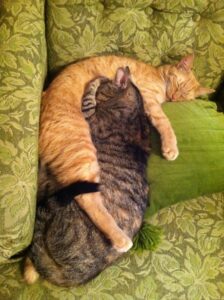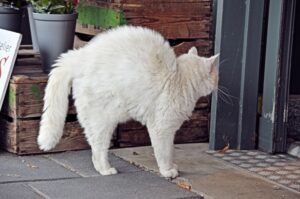Most feline communication is far more subtle than that of a dog. While our canine friends frequently wear their hearts on their sleeves (if they wore them), cats tend to be much tougher to decipher.
The way cats interact with each other may tell us something about how and why they interact with us. Cats have three major physical cues which communicate their current state: posture, facial expression  and tail position. Cats know to read all three of these places to feel out another cat, but because humans (and dogs, who may share a household with a cat) speak a different language, we may miss or misread the cat’s cues.
and tail position. Cats know to read all three of these places to feel out another cat, but because humans (and dogs, who may share a household with a cat) speak a different language, we may miss or misread the cat’s cues.
Careful study can reveal that cats do have facial expressions, though nothing as pronounced as a dog has. When feeling stressed or anxious or other negative things, their facial muscles are tense; when cats are relaxed or happy or experiencing positive things, they relax their facial muscles.
Feral cats in colonies have been observed rubbing against each other or wrapping their tails over another cat’s back. This behavior carries over to their human interactions when they drape their tail over their owner’s legs, for example; it may be a way of welcoming them back or reconnecting with them, like a hug.
 Speaking of tails, it is one of the cat’s main forms of expression. A relaxed cat, tail held up in the air with the tip high, means the cat is open to interaction. If the cat’s hair is bristling and its tail is held straight down or like an upside-down U, though, it is likely scared or upset in some way and not in the mood for games. And if you see a cat’s tail lashing or thumping, watch out– that cat just wants to be left alone, and now.
Speaking of tails, it is one of the cat’s main forms of expression. A relaxed cat, tail held up in the air with the tip high, means the cat is open to interaction. If the cat’s hair is bristling and its tail is held straight down or like an upside-down U, though, it is likely scared or upset in some way and not in the mood for games. And if you see a cat’s tail lashing or thumping, watch out– that cat just wants to be left alone, and now.
We hope you’ve enjoyed our brief look at feline communication, from purring and meowing to body language. Hopefully these articles have helped you understand your kitty companion just a little bit better.
Recent Posts
About Us
Ann Arbor Animal Hospital is a locally-owned animal hospital operating for over 90 years in Ann Arbor, MI.
